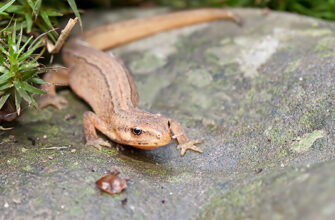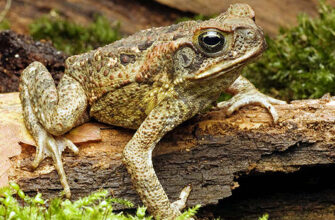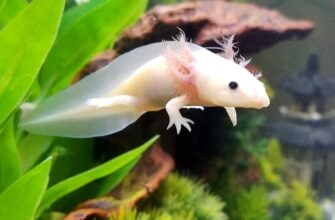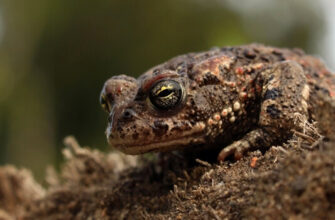Salamander is an amphibian, which in ancient times people were very afraid of, composed legends about it, revered it, and also attributed magical abilities. This was due to the appearance of the salamander and its behavior. For a long time, people believed that the animal does not burn in fire, since it is itself made of fire. After all, translated from the language of the ancient Persians, the salamander means “burning from the inside.”
Origin of the species and description
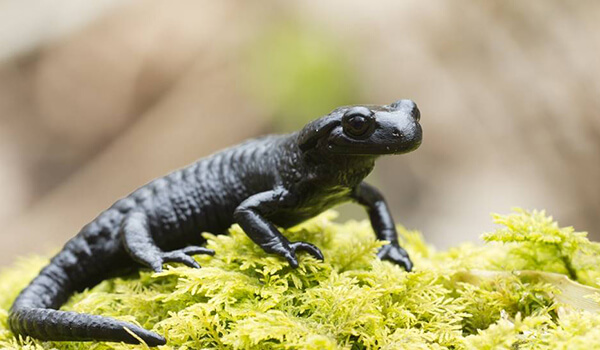
Photo: Salamander
In their appearance, salamanders strongly resemble lizards, but are assigned by zoologists to different classes: lizards – to the class reptiles, and salamanders belong to the amphibian class, the salamander genus.
In the process of evolution, which lasted millions of years, all representatives of the genus were divided into three main groups:
- real salamanders (Salamandridae);
- lungless salamanders (Plethodontidae);
- hiddenbranch salamanders (Сryptobranchidae).
All three groups differ in the respiratory system, which is arranged in completely different ways. For example, the first breathe with the help of lungs, the second – with the help of mucous membranes and skin, the third – with the help of hidden gills.
Video: Salamander
The body of salamanders is elongated, smoothly turning into a tail. Amphibians range in size from 5 to 180 cm. The skin of salamanders is smooth to the touch and always moist. Their color scheme is very diverse depending on the species and habitat: yellow, black, red, olive, green, purple hues. The back and sides of animals can be covered with large and small spots, stripes of various colors.
Interesting fact: The smallest salamander in the world is the dwarf Eurycea quadridigitat with a body length of up to 89 mm, and very tiny Desmognathus wrighti with a body length of up to 50 mm. And withthe largest salamander in the world, Andrias davidianus, living in China, reaches a length of up to 180 cm.
The legs of salamanders are short and stocky. There are 4 fingers on the forelimbs, and 5 on the hind limbs. There are no claws on the fingers. The head is flattened, similar to the head of a frog with bulging and, as a rule, dark eyes with moving eyelids.
In the skin of animals there are special glands (mumps) that produce poison. The poison of salamanders is usually not fatal, but when you try to eat it, it can paralyze the predator for some time, and also cause convulsions in him. Salamanders live almost everywhere where the climate is warm and humid, but their greatest species diversity can be found in North America.
Appearance and Features
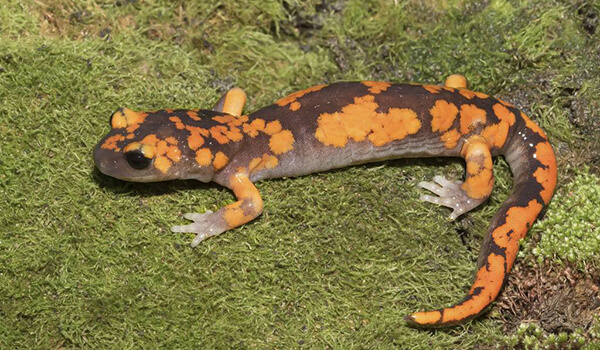
Photo: What a salamander looks like
All salamanders are very similar in appearance: they have an elongated body with smooth, slimy skin, a rather long tail, not too developed limbs without claws, a small head with bulging black eyes and movable eyelids, allowing you to explore the surroundings without turning your head. The jaws of amphibians are poorly developed, since they are not at all adapted to eating hard food. Because of their clumsiness, animals feel much more comfortable in water than on land.
Salamanders, unlike their closest relatives – lizards, are also very interesting with a variety of colors of literally all colors of the rainbow. As usual in nature, behind a bright and spectacular appearance lies a danger – a poison that can burn and even kill. All species of salamanders are poisonous to one degree or another, but only one species of these animals, the Fire Salamander, has a deadly poison.
In myths and legends composed in antiquity, the salamander has always been assigned the role of a servant of the dark forces. This prejudice existed partly because of the unusual appearance, and also because of the possibility, in case of danger, of producing a poisonous secretion from the skin, capable of both causing severe skin burns (in humans) and paralyzing or even killing (smaller animals). p>
Now you know if the salamander is poisonous or not. Let's see where this amphibian lives.
Where does the salamander live?
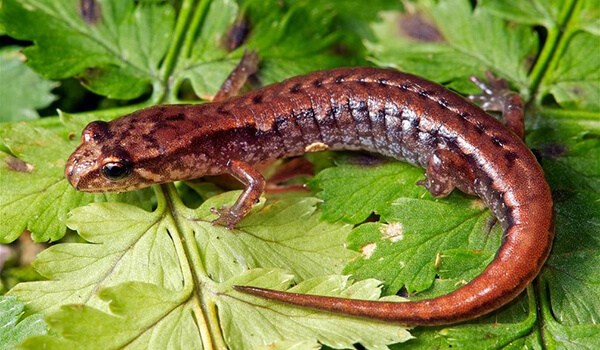
Photo: Salamander in Russia
Salamander habitat quite extensive. To summarize, they live almost everywhere, on all continents, where there is a warm, mild and humid climate without sharp changes in seasonal, day and night temperatures. However, most of the species can be seen in North America.
Alpine salamanders, of course, live in the Alps (eastern and central parts of the mountains), and they can be found at an altitude of up to 1000 m above sea level. Also, salamanders are quite common in Switzerland, Austria, Italy, Slovenia, Croatia, >Bosnia, Serbia, Montenegro, Herzegovina, southern France, Germany and Liechtenstein.
There are species that live in a very limited area . For example, the Lanza salamander lives exclusively in the western part of the Alps, literally on the border of Italy and France, in the Chisone Valley (Italy), in the valleys of the Po, Gil, Germanaska, Pellice rivers.
Many species of the most diverse species of salamanders are found in Western Asia and throughout the Middle East region – from Iran to Turkey.
An interesting fact: One of the most poisonous salamanders, the alpine black salamander, lives in the Carpathians. The poison of the animal, secreted through the skin through special glands, causes very severe burns on the skin and mucous membranes, which do not heal for a very long time.
What does it eat salamander?
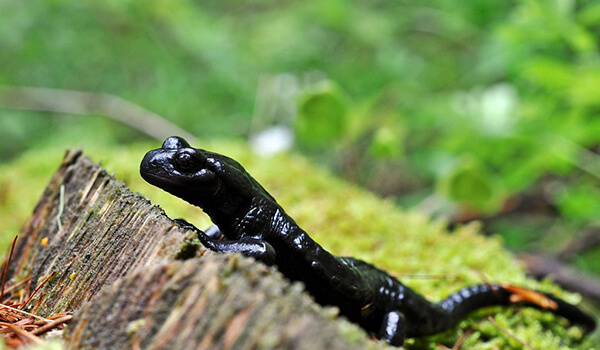
Photo: Black Salamander
What salamanders eat depends mainly on their habitat. For example, small amphibians living on land prey on flies, mosquitoes, butterflies, spiders, cicadas, earthworms, slugs. Larger salamanders prefer to hunt small lizards, newts, frogs. Animals living in water bodies catch crustaceans, mollusks, small fish, fry.
When climatic conditions allow, amphibians can hunt all year round. The period of greatest activity of salamanders falls at night. In the dark, they come out of their hiding places to walk and hunt, and they can do this from evening until dawn.
To catch their prey, they first watch it for a long, long time without moving, thanks to their bulging eyes and moving eyelids. They catch salamander prey by throwing out their long and sticky tongue. If the animal managed to approach the prey imperceptibly, then it probably won’t be saved.
Having caught their prey with a sharp movement, they lean on it with their whole body and try to swallow it whole without chewing. After all, the jaws and mouth of the salamander are not at all adapted for chewing. With small living creatures (insects, slugs), everything turns out simply, with larger prey (lizards, frogs), the animal has to try hard. But then the salamander feels full for several days.
Character and lifestyle features
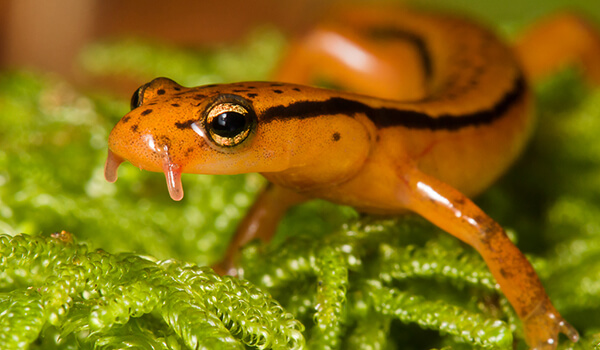
Photo: Orange Salamander
Salamanders move rather slowly, and in general they move very little, and more and more sit in one place, lazily examining the surroundings. Animals are most active at night, and during the day they try to hide in abandoned burrows, old stumps, in thick grass, in heaps of rotten brushwood, avoiding direct sunlight.
Salamanders also hunt and breed at night. Near their habitat there must be at least some kind of reservoir. After all, salamanders cannot live without water, and all because their skin quickly dehydrates.
If salamanders do not live in the tropics, then from mid-autumn they begin the wintering season, which, depending on the region of habitat, can last until almost mid-spring. At this time, deep abandoned burrows or large piles of fallen leaves serve as a home for them. Salamanders can winter both alone, which is more typical for them, and in groups of several dozen individuals.
In the wild, salamanders have many enemies, therefore, in order to escape, animals secrete a poisonous secret that paralyzes the jaws of predators. If this does not help, they may even leave their limbs or tail in their teeth or claws, which will grow back after a while.
Social Structure and Reproduction
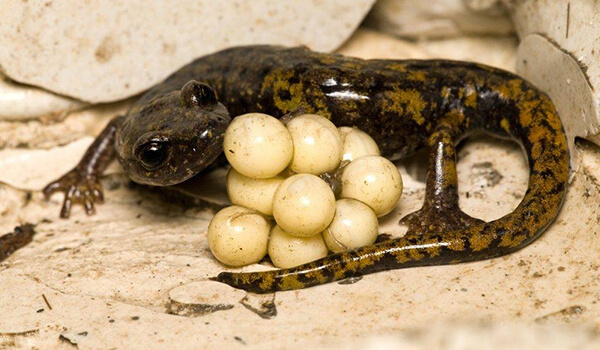
Photo: Salamander eggs
On average, salamanders can live up to 20 years, but their lifespan varies by species and habitats. Small species of these animals become sexually mature at 3 years old, and large ones later — at 5 years old.
Cryptobranch salamanders lay eggs, while true salamanders can be either viviparous or ovoviviparous. Amphibians can breed throughout the year, but the peak of mating activity falls on the spring months.
When the male salamander is ready to mate, he swells a special gland filled with spermatophore – male sex cells. He is very excited and the main goal of his life at this moment is to find a female and fulfill the duty of procreation. If there are several applicants for the attention of the female, then the males can fight.
The spermatophore is secreted by males directly to the ground, and females absorb it into themselves through the cloaca. In water, the process of fertilization occurs differently: females lay eggs, and males water them with spermatophore.
Fertilized eggs are attached to algae stems or their roots. In viviparous species, larvae develop inside the womb within 10-12 months. In aquatic salamanders, the young hatch from eggs after about 2 months with gills already fully formed. In appearance, the larvae are somewhat reminiscent of tadpoles.
An interesting fact: In viviparous salamanders, out of 30-60 fertilized eggs, only 2-3 cubs are born, and the rest of the eggs are just food for future offspring.
Salamander larvae live and feed in water for about three months, gradually transforming and acquiring the appearance of adults. Before the completion of the metamorphosis, small salamanders crawl a lot along the bottom of the reservoirs and often emerge, trying to get some air. Juveniles have no connection with their parents, and upon completion of metamorphosis, they begin their independent life.
Natural enemies of salamanders
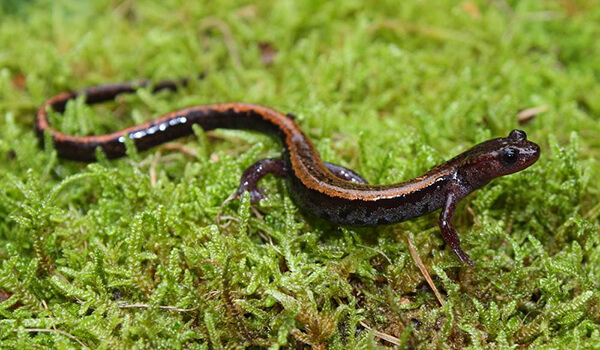
Photo: Salamander in nature
In nature, salamanders, due to their slowness and peculiar motley bright coloring, have many enemies, since they are very easy to spot. The most dangerous of them are snakes, as well as larger poisonous and non-venomous snakes.
They also better not to catch the eye of large birds – falcons, hawks, eagles, owls. Birds usually do not swallow amphibians alive – this is fraught, since you can get a decent portion of poison. Usually, birds grab salamanders with their claws and kill them by throwing them from a height onto stones, and only then they start eating, unless, of course, no one dragged the prey, which happens quite often.
Also, wild boars, martens and foxes are not averse to eating salamanders. Moreover, it is wild boars who manage to hunt them with great success, since these animals have a rather large mouth, which allows you to quickly swallow the prey, while it has not yet had time to come to its senses and extract poison from the skin. Foxes and martens in this regard have a much more difficult time – prey can have time to paralyze their jaws with poison or even run away, leaving a paw or tail in their teeth.
In the aquatic environment, salamanders also have many enemies. Animals, but more often their larvae, can dine on any large predatory fish – catfish, perch or pike. Smaller fish also love eggs.
Population and species status
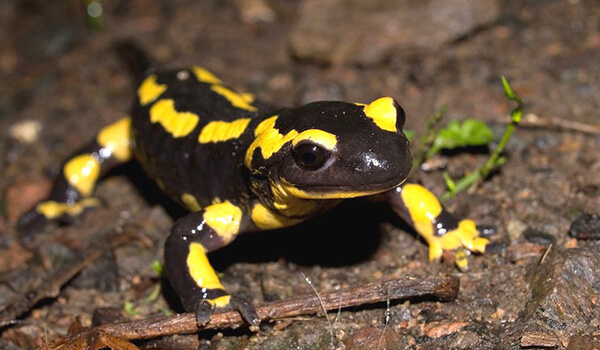
Photo: What a salamander looks like
Due to its variability, diversity and vast habitat, zoologists have identified many species and subspecies of salamanders. Previously, there were seven main species of salamander, but recent biochemical studies of the genetic material have shown that there are only four.
The main types of salamanders:
- Maghreb salamander (Salamandra algira Bedriaga), found and described in 1883 in Africa;
- Corsican salamander (Salamandra corsica Savi), described in 1838 on the island of Corsica;
- Western Asian salamander (Salamandra infraimmaculata Martens), described in 1885 in Western Asia and having 3 subspecies (with 3 subspecies);
- spotted salamander (Salamandra salamandra) described in 1758, living in Europe and the European part former USSR, which has 12 subspecies.
Of all the known subspecies, the Fire salamander is the most studied.
The venom of most species of salamanders is considered not fatal to humans, but it is very dangerous, because if it comes into contact with the skin, it can cause severe burns. For this reason, it is highly undesirable to take salamanders in your hand. In general, salamanders are not too dangerous animals. After all, they never attack people themselves, since they have neither sharp claws nor teeth for this.
Salamander Guard
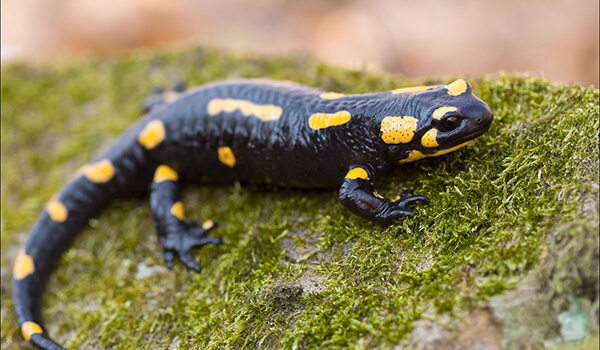
Photo: Red Book Salamander
Many species of salamanders are listed in the Red Book under the statuses: «vulnerable species» or «disappearing view». Their number is constantly declining due to the development of industry and agriculture, land reclamation, deforestation, and, as a result, the constant narrowing of their habitat. There are less and less suitable places for these animals to live on land and water bodies.
People who are concerned about this problem in different countries are making a lot of efforts to preserve all these species by creating reserves and specialized nurseries.
Of the species found in Europe, the Fire or Spotted Salamander is protected by the «Bern Convention for the Protection of Rare Species and Their Habitats in Europe». Also, this species is listed in the Red Book of Ukraine under the status «vulnerable species». In Soviet times, the species was under the protection of the Red Book of the USSR. Today, work is underway to enter the spotted salamander in the Red Book of Russia.
The spotted salamander lives in Europe (center and south) from the Iberian Peninsula to Germany, Poland, the Balkans. In Ukraine, the species lives in the Carpathian region (east), is much less common in the river valleys of the Lviv, Transcarpathian, Chernivtsi, Ivano-Frankivsk regions, as well as in the Carpathian National Park and the Carpathian Reserve.
Interesting fact: The spotted salamander produces a unique type of poison that is not found anywhere else in any animal. It has a special name – samandarin, belongs to the group of steroidal alkaloids and acts as a neurotoxin. Research has suggested that the most important function of this venom is not to protect against predators, but to have a very strong antifungal and antibacterial effect, helping to keep the animal's skin clean and healthy. Since the salamander breathes through the skin, the health and cleanliness of the skin for the animal means a lot.
The salamander leads a hidden lifestyle. This feature makes it very difficult to study their life and habits. Due to the fact that little was known about salamanders, they had a hard time in the old days. People were afraid of animals and burned them in the fire. Salamanders, trying to avoid their fate in a panic, jumped out of the fire and ran away. So the legend was born that with their poison they can extinguish the fire and, as it were, be reborn.

